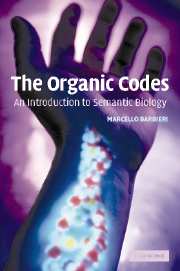Book contents
- Frontmatter
- Contents
- Foreword
- Dedication
- Acknowledgements
- Introduction
- Chapter 1 The microscope and the cell
- Chapter 2 Theories of evolution
- Chapter 3 A new model for biology
- Chapter 4 Organic codes and organic memories
- Chapter 5 The origin of life
- Chapter 6 Prokaryotes and eukaryotes
- Chapter 7 The Cambrian explosion
- Chapter 8 Semantic biology
- Chapter 9 A brief summary
- Appendix: Definitions of life
- Afterword
- References
- Index
Chapter 6 - Prokaryotes and eukaryotes
Published online by Cambridge University Press: 23 November 2009
- Frontmatter
- Contents
- Foreword
- Dedication
- Acknowledgements
- Introduction
- Chapter 1 The microscope and the cell
- Chapter 2 Theories of evolution
- Chapter 3 A new model for biology
- Chapter 4 Organic codes and organic memories
- Chapter 5 The origin of life
- Chapter 6 Prokaryotes and eukaryotes
- Chapter 7 The Cambrian explosion
- Chapter 8 Semantic biology
- Chapter 9 A brief summary
- Appendix: Definitions of life
- Afterword
- References
- Index
Summary
After the origin of life, our planet has been inhabited only by single cells for some 3000 million years, i.e. for more than 85% of the entire history of life on Earth. Multicellular creatures appeared only at the end of that unimaginably long period, but when they did they quickly diversified into all known kingdoms. This chapter presents a brief account of what we can reconstruct about the age of the cell, and its conclusions are not always in line with present thinking. It is shown, for example, that the bacteria-first view is unlikely to be correct, despite it persistent popularity. Another minor unorthodox conclusion is that the kingdoms of life are probably seven, and not five or six as reported in most textbooks. The major divergence from orthodoxy, however, comes from the fact that cellular evolution is reconstructed by taking organic codes into account. The emergence of the cell nucleus, for example, is related to the full development of the splicing codes, because it is these codes that allow a physical separation, in space and time, between transcription and translation. There are also good arguments for the existence of cytoskeleton codes and compartment codes, thus suggesting that these were instrumental to the evolution of other major eukaryotic structures. The idea that organic codes have something to do with the great events of macroevolution, in brief, does not seem unreasonable, and gives substance to the concept of evolution by natural conventions.
- Type
- Chapter
- Information
- The Organic CodesAn Introduction to Semantic Biology, pp. 163 - 190Publisher: Cambridge University PressPrint publication year: 2002



